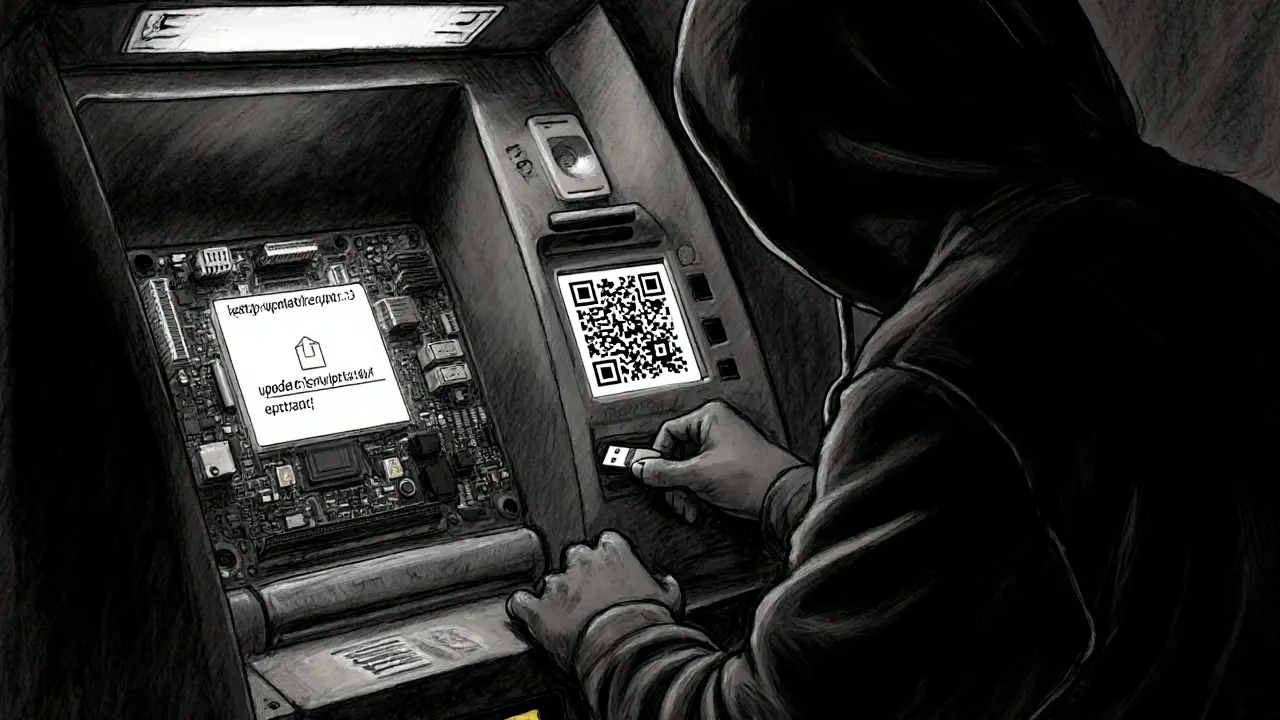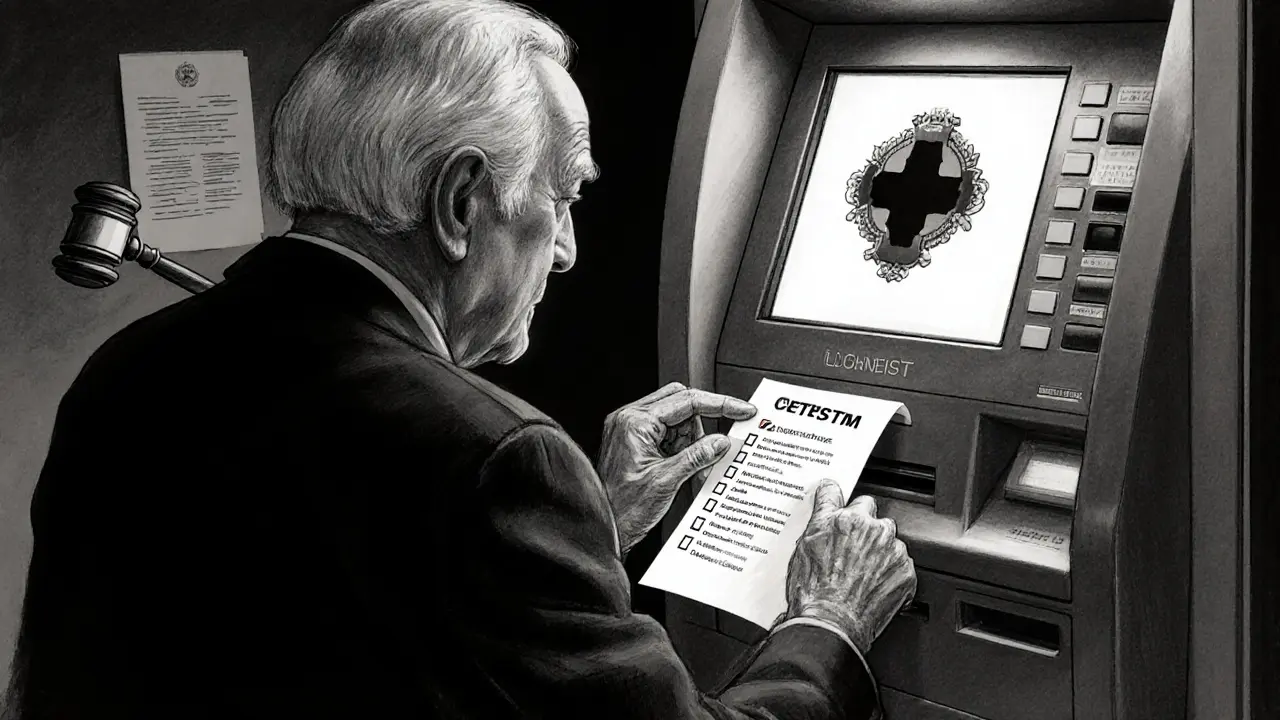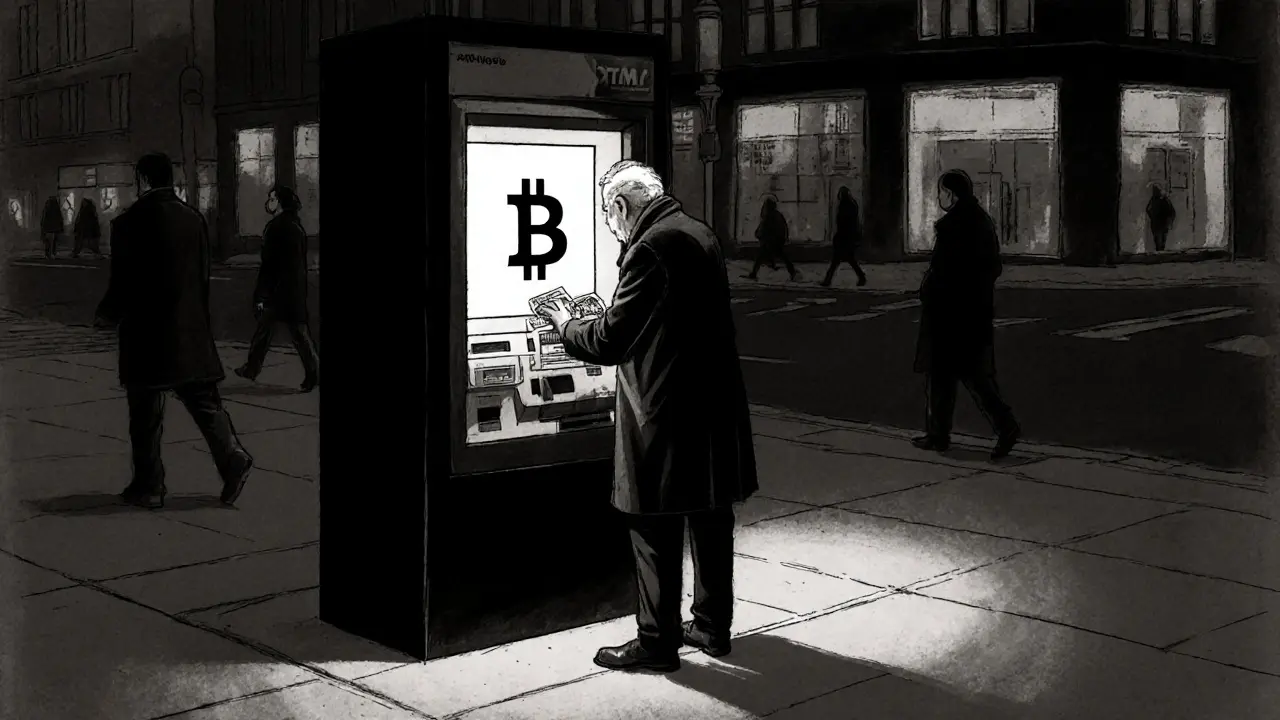Crypto ATM Safety Checker
Evaluate a Crypto ATM
Use this tool to assess whether a cryptocurrency ATM is likely safe or risky based on key indicators.
Safety Assessment Result
Imagine walking up to a kiosk, slipping cash in, and watching a Bitcoin appear on the screen. Easy, right? Yet that same convenience has become a hotbed for fraud, costing victims $246.7million in just one year. This piece pulls together the latest data, reveals how scammers exploit technical flaws and weak regulation, and gives you practical steps to stay safe.
TL;DR
- Crypto ATM scams have generated over $246million in losses in 2024.
- Most victims are seniors - two‑thirds of complaints involve people over 60.
- Key vulnerabilities include unpatched software (e.g., CVE‑2024‑0674) and poor KYC practices.
- FinCEN’s 2025 notice and Arizona’s new law are the first major regulatory moves.
- Protect yourself: verify the operator, limit transaction size, and keep receipts.
What Exactly Is a Crypto ATM?
Cryptocurrency ATM is a specialized kiosk that lets users exchange cash or debit cards for digital assets such as Bitcoin, Ethereum, or stablecoins, and vice‑versa. Unlike traditional bank ATMs, these machines operate under a lighter regulatory regime and often forgo the exhaustive identity checks required by the Bank Secrecy Act.
Manufacturers like Lamassu, General Bytes, and CoinFlip ship hardware with touch‑screen interfaces, QR‑code scanners, and cash‑accepting modules. The user experience is intentionally simple: insert cash, scan a wallet address, confirm the amount, and walk away with crypto on the blockchain.
How Scams Slip Through the Cracks
Scammers prey on two weak points: technical flaws in the kiosk software and the regulatory blind spot that leaves operators unchecked.
Lamassu Douro Bitcoin ATM exemplifies the technical risk. In March2024, IOActive researcher Gabriel Gonzalez disclosed three critical vulnerabilities (CVE‑2024‑0674, CVE‑2024‑0675, CVE‑2024‑0676). The most severe, CVE‑2024‑0674, allowed an attacker to drop a malicious updatescript.js file in /tmp/extract/package/ and trigger a firmware update, gaining full root access. With that foothold, fraudsters can install malware that intercepts QR‑code scans, replaces wallet addresses, and siphons funds in real time.
But most victims never encounter a hacked machine. Instead, scammers use social‑engineering scripts. A common pattern: a “crypto investment” flyer promises a 10% bonus for using a nearby ATM. The flyer includes a fake QR code pointing to the attacker’s wallet. Unsuspecting users deposit cash, scan the code, and watch their money disappear instantly.
The $246Million Epidemic
The FBI’s Internet Crime Complaint Center (IC3) logged 10,956 complaints in 2024 alone, with total victims losing $246.7million. That figure represents a sharp upward trajectory from prior years, driven by the explosive growth of crypto kiosks nationwide.
Geographically, Arizona bears the brunt. Statewide, more than 600 crypto ATMs processed an estimated $2billion in transactions in 2024, and scammers ripped out $177million-roughly one‑third of the national total. Scottsdale police reported a $5million loss in just the first quarter, while Peoria families collectively lost nearly $1million the previous year.
Demographically, seniors are the most vulnerable. FBI data shows that over two‑thirds of crypto ATM fraud victims were older than 60, marking a 99% jump compared with 2023. Many cite “shame” and “lack of technical know‑how” as reasons they avoid reporting the crime.

Regulatory Gaps and Emerging Rules
Unlike traditional ATMs, crypto kiosks are largely unregulated. The National Consumers League describes them as “largely unregulated,” meaning many operators skip the BSA’s customer‑identification and transaction‑monitoring requirements.
In August2025, the U.S. Treasury’s Financial Crimes Enforcement Network (FinCEN) issued Notice FIN‑2025‑NTC1, formally warning financial institutions about heightened risks. The notice outlines “red‑flag indicators” such as rapid cash‑in to crypto conversions, repeated small‑value transactions, and the absence of AML software on the kiosk.
At the state level, Arizona pioneered the most comprehensive response. Under the new Cryptocurrency Kiosk License Fraud Prevention law, new customers are limited to $2,000 per day, while existing customers can move up to $10,500. Operators must display full‑screen warning screens that users must acknowledge before proceeding, and they are required to issue full refunds (including fees) for fraud reported within 30days.
Other states are following suit. In 2025, at least 11 states introduced or passed legislation targeting crypto ATMs, ranging from mandatory licensing to transaction‑limit caps.
Comparison: Crypto ATMs vs. Traditional ATMs
| Feature | Crypto ATM | Traditional ATM |
|---|---|---|
| Regulatory Oversight | Minimal; many operators skip BSA/KYC | Extensive federal and state banking regulations |
| Transaction Reversibility | Irreversible once blockchain confirms | Can be disputed and reversed within days |
| Identity Verification | Often none or basic phone/email check | Requires card, PIN, and often photo ID |
| Fraud Monitoring | Limited or absent real‑time analytics | Real‑time fraud detection, alerts, and blocking |
| Fees | Typically 5‑10% per transaction | Usually flat fees or free for account holders |
Practical Tips to Avoid Falling Victim
- Verify the operator. Look for a license number displayed on the screen. Arizona‑based kiosks, for example, must show the Cryptocurrency Kiosk License badge.
- Check the QR code twice. Use a separate wallet app to scan the code before confirming the transaction. If the address looks unfamiliar, abort.
- Limit cash‑in amounts. The larger the sum, the harder it is to trace and recover.
- Keep the receipt. Arizona law requires operators to issue a detailed receipt; it’s your only paper trail for a refund claim.
- Be wary of “bonuses” or “guaranteed returns.” Scammers use promises of extra crypto to lure users into quick deposits.
- Use a hardware wallet for storage. Leaving funds in an exchange or web wallet makes it easier for thieves to steal later.
- Report suspicious activity within 30 days. Under the Arizona law, you’re eligible for a full refund if you act promptly.
Industry Response and Outlook
Security firms are scrambling to patch vulnerable models. Lamassu released a firmware update in June2025 that closes the CVE‑2024‑0674 exploit, but many operators continue to run outdated software due to cost or lack of expertise.
Experts like James Wyler, President of Trusted Security Solutions, warn that the next wave may involve quantum‑ready attacks that bypass current encryption altogether. He stresses that “the core design of crypto-decentralization and irreversibility-conflicts with traditional fraud‑prevention methods, so regulators must innovate.”
On the advocacy side, Nancy LeaMond of AARP highlighted bipartisan support for consumer‑friendly rules. “Lawmakers on both sides recognize the need for common‑sense safeguards without killing innovation,” she said.
Looking ahead, the combination of stricter state licensing, FinCEN’s red‑flag guidance, and industry‑wide firmware updates should curb the most egregious scams. However, the $246million loss figure signals that many users are still unaware or unprotected. Continuous education-especially for seniors-remains the most effective defense.
Quick Checklist for Safe Crypto ATM Use
- Confirm the kiosk displays a valid state license.
- Scan QR codes with a trusted wallet before confirming.
- Limit each transaction to under $2,000 if you’re a new user (per Arizona rules).
- Keep the printed receipt and photograph the screen.
- Report suspicious activity within 30days for potential refunds.
- Regularly update your personal crypto wallet software.

Frequently Asked Questions
Why are crypto ATMs considered high‑risk compared to regular ATMs?
Crypto ATMs often operate without the strict KYC, AML, and real‑time fraud monitoring that banks must follow. Once a blockchain transaction confirms, it cannot be reversed, giving scammers a one‑shot opportunity to steal funds.
What is the most common way scammers trick users at a crypto ATM?
The typical method is a fake QR code on a flyer or screen that points to the attacker’s wallet. Users think they’re sending money to themselves, but the crypto lands in the scammer’s address.
Can I get my money back if I fall victim to a crypto ATM scam?
Recovery is rare because the transaction is final on the blockchain. However, states like Arizona now require operators to refund the amount (including fees) if the victim reports the fraud within 30days.
Are there any crypto ATMs that are considered "secure"?
Security depends on how up‑to‑date the firmware is and whether the operator complies with AML/KYC rules. Look for machines that display a valid licensing badge and have recently posted firmware version numbers.
How does FinCEN’s 2025 notice affect everyday users?
FinCEN’s guidance pushes banks and crypto service providers to flag suspicious ATM activity, share red‑flag indicators with law‑enforcement, and require better identity verification. In practice, users should see more warning screens and tougher transaction limits.


Thank you for shedding light on this serious issue, the sheer scale of the losses is staggering, and it underscores the urgent need for better consumer protection, especially for seniors who are most vulnerable.
While the article emphasizes the dangers, it neglects to mention that many of these so‑called scams are simply the result of reckless users ignoring basic security protocols; a balanced view would credit personal responsibility alongside regulatory failures.
Stay vigilant and keep learning; knowledge is the best defense against these schemes.
Interesting read! I've seen a few of those QR‑code flyers around Toronto-always double‑check the address before you tap that cash in. 😊
Cool article, definitely gonna keep an eye on those license stickers next time.
Great breakdown! A couple of extra tips: always verify the ATM firmware version on the screen, and if the receipt looks generic or missing key details, walk away. Also, consider using a hardware wallet for any crypto you buy-software wallets can be compromised too. And for seniors, a simple checklist posted on the fridge can save a lot of grief. Remember, scammers thrive on haste; taking a moment to scan and verify can stop a fraud in its tracks.
From a policy perspective, the FinCEN notice is a step forward, but it will only be effective if state regulators enforce licensing uniformly. Operators should also adopt real‑time monitoring tools that flag abnormal transaction patterns. In practice, users will benefit from clearer on‑screen warnings that explain the risks in plain language, rather than dense legalese.
Love the info-just a heads up, some ATMs still run old firmware, so make sure you ask the staff to update. The sistems woudl be more safe if they had the latest patches.
This article overstates the "epidemic" narrative, ignoring the fact that the majority of crypto transactions remain secure; the sensationalist tone merely fuels panic, which is counterproductive to rational risk management.
Sure, because everyone loves losing $2,000 to a malfunctioning kiosk. 🙄
Obviously, anyone who falls for a fake QR code must be living in the stone age. The article underestimates the intellect of the average user-just read the fine print, duh.
One could argue that the very concept of a "crypto ATM" challenges traditional notions of trust. If we accept that trust is decentralized, then perhaps the focus should be on education rather than regulation.
Stay safe out there! 👍
USA needs stricter rules now.
In reviewing the presented data, several methodological concerns arise that merit rigorous scrutiny. First, the sample selection appears to be biased toward jurisdictions with proactive reporting mechanisms, potentially inflating the apparent prevalence of scams. Second, the reliance on FBI IC3 complaint figures neglects unreported incidents, thereby limiting the comprehensiveness of the analysis. Third, the article conflates distinct threat vectors-software vulnerabilities and social engineering-without adequately differentiating their respective impact on loss magnitude. Fourth, the discussion of CVE‑2024‑0674 lacks a nuanced technical exposition, which could mislead readers regarding the exploit’s actual capabilities. Fifth, the proposed regulatory response, while commendable, does not address cross‑border enforcement challenges that are inherent to decentralized asset ecosystems. Sixth, the recommendation to limit transaction size to $2,000 for new users may inadvertently push high‑risk actors toward alternative, less regulated channels. Seventh, the citation of Arizona’s refund mandate assumes uniform compliance by operators, an assumption that is empirically unverified. Eighth, the article’s emphasis on receipt retention overlooks the cryptographic nature of blockchain confirmations that render traditional paper trails largely symbolic. Ninth, the discussion of hardware wallet adoption, though valuable, fails to consider the user‑experience barriers that may deter less technically proficient individuals. Tenth, the mention of quantum‑ready attacks is speculative at this juncture and detracts from the immediate risk landscape. Eleventh, the narrative’s focus on seniors, while crucial, would benefit from granular demographic segmentation to identify specific vulnerability factors. Twelfth, the suggestion to employ “trusted wallets” for QR verification is sound, yet the article does not provide concrete wallet recommendations or criteria for trustworthiness. Thirteenth, the assertion that FinCEN’s notice will catalyze industry-wide best practices lacks empirical support given historical implementation lags. Fourteenth, the comparative table of ATM features could be expanded to include data on post‑transaction monitoring capabilities. Finally, the overall tone of the piece oscillates between alarmist and advisory, which may dilute the intended call to action for both consumers and policymakers.
Excellent deep‑dive! 👏 The technical breakdown really helps demystify the risks. Keep the tips coming! 🚀
Wow, the drama of a $5 million loss in a single quarter feels like a thriller! The scene where a fake QR code swaps wallets is straight out of a cyber‑crime blockbuster.
All these regulations are a good start, but we need louder voices demanding accountability-let's make sure these kiosks are transparent and secure for everyone.
The article glosses over the personal responsibility factor; blaming only the machines creates a false sense of victimhood.
Honestly, the hype around crypto ATMs is overblown. Most of the risk comes from users not doing basic checks.
Why should we trust a device that lets you put cash in without any ID? The system is fundamentally flawed.
We could also argue that the whole crypto ATM model is a scam in disguise, just a glorified money‑laundering front.
Let's keep the conversation moving forward-education, proper firmware updates, and clear regulatory frameworks are the keys to safety.
In sum, the proliferation of crypto ATMs presents a paradox: they democratize access yet amplify exposure to fraud; thus, a holistic approach-combining technology, policy, and user education-is indispensable.